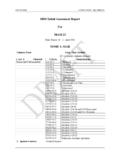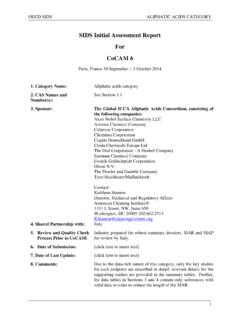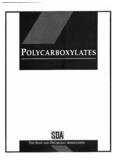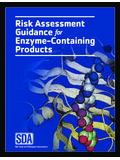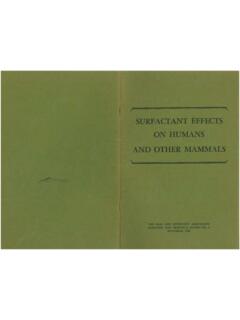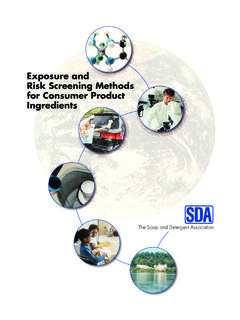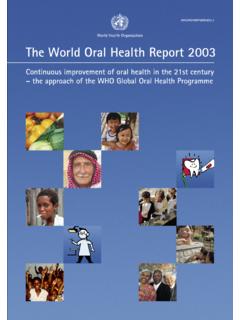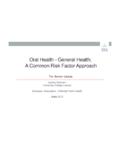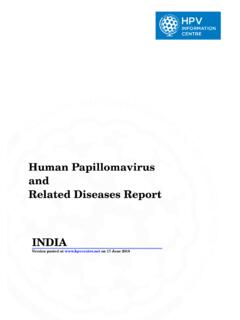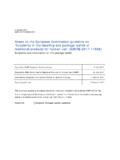Transcription of SIDS Initial Assessment Report
1 State of: 2007-12-19 sids Initial Assessment Repor t For SIAM 25 16-19 October 2007, Helsinki 1. Chemical Name: Category of Alkyl sulfates, Alkane sulfonates and -Olefin sulfonates 2. CAS Number: See Tables 1-1 and 1-2 3. Sponsor Country: Germany Contact Point: BMU (Bundesministerium f r Umwelt, Naturschutz und Reaktorsicherheit) Contact person: Dr. Reiner Arndt Postfach 12 06 29 D-53048 Bonn 4. Shared Partnership with: SDA / Alkylsulfate Consortium 5. Roles/Responsibilities of the Partners: Name of industry sponsor /consortium SDA / Alkylsulfate Consortium Process used The BUA Peer Review Process: see next page 6. Sponsorship History How was the chemical or category brought into the sids Program? By ICCA HPV Initiative 7. Review Process Prior to the SIAM: last literature search (update): 31 August 2006 (Ecotoxicology and Human health ): databases Biosis, Embase, Medline, Toxline, Scisearch; search profile CAS-No.
2 And special search terms 8. Quality check process: As basis for the sids -Dossier the IUCLID was used. All data have been checked and validated by BUA. A final evaluation of the human health part has been performed by the Federal Institute for Risk Assessment (BfR) and of the ecotoxicological part by the Federal Environment Agency (UBA). 9. Date of Submission: Deadline for circulation: 18 July 2007 state of: 2007-02-22 2 10. Date of last Update: 11. Comments: OECD/ICCA - The BUA* Peer Review Process Qualified BUA personnel (toxicologists, ecotoxicologists) perform a quality control on the full sids dossier submitted by industry. This quality control process follows internal BUA guidelines/instructions for the OECD/ICCA peer review process and includes: - a full (or update) literature search to verify completeness of data provided by industry in the IUCLID/HEDSET - Review of data and Assessment of the quality of data - Review of data evaluation - Check of adequacy of selection process for key studies for OECD endpoints, and, where relevant, for non-OECD endpoints by checking original reports/publications - Review of key study description according robust summaries requirements.
3 Completeness and correctness is checked against original reports/publications (if original reports are missing: reliability (4), reliability not assignable) - Review of validity of structure-activity relationships - Review of full sids dossier (including SIAR, SIAP and proposal for conclusion and recommendation for further work) - In case of data gaps, review of testing plan or rationale for not testing * BUA (GDCh-Beratergremium f r Altstoffe): Advisory Committee on Existing Chemicals of the Association of German Chemists (GDCh) OECD sids CATEGORY OF ALKYL SULFATES, ALKANE SULFONATES AND ALPHA-OLEFIN SULFONATES 3 CONTENTS 1 identity 8 IDENTIFICATION OF THE SUBSTANCES 8 PURITY/IMPURITIES/ADDITIVES 13 PHYSICO-CHEMICAL PROPERTIES 15 CATEGORY JUSTIFICATION 22 2 general information on exposure 29 PRODUCTION VOLUMES AND USE PATTERN 29 ENVIRONMENTAL EXPOSURE AND FATE 33 SOURCES OF ENVIRONMENTAL EXPOSURE 33 PHOTODEGRADATION 36 STABILITY IN WATER 37 TRANSPORT BETWEEN ENVIRONMENTAL COMPARTMENTS 37 BIODEGRADATION 39 BIOACCUMULATION 44 HUMAN EXPOSURE 45 OCCUPATIONAL EXPOSURE 45 CONSUMER EXPOSURE 46 3 human health hazards 49 EFFECTS ON HUMAN health 49 TOXICOKINETICS.
4 METABOLISM AND DISTRIBUTION 49 ACUTE TOXICITY 54 IRRITATION 64 SENSITIZATION 70 REPEATED DOSE TOXICITY 76 MUTAGENICITY 89 CARCINOGENICITY 96 TOXICITY FOR REPRODUCTION 101 Initial Assessment FOR HUMAN health 108 4 hazards to the environment 112 OECD sids CATEGORY OF ALKYL SULFATES, ALKANE SULFONATES AND ALPHA-OLEFIN SULFONATES 4 AQUATIC EFFECTS 112 TERRESTRIAL EFFECTS 133 OTHER ENVIRONMENTAL EFFECTS 134 Initial Assessment FOR THE ENVIRONMENT 134 5 recommendations 137 6 references 138 Annex I: Category Rationale for the Anionic Surfactants (ANS) Category 164 Annex II 180 ANNEX III 183 ANNEX IV 191 Annex V: Use and Exposure Information 219 OECD sids CATEGORY OF ALKYL SULFATES, ALKANE SULFONATES AND ALPHA-OLEFIN SULFONATES 5 Tables Table 1-1: HPV substances of the ANS category .. 9 Table 1-3: Composition of the HPV substances of the ANS category .. 14 Table 1-4: Surfactant properties for some alkyl sulfates (for references cf.)
5 IUCLID datasets) .. 16 Table 1-5: Summary of physico-chemical properties of HPV chemicals with single chain length .. 18 Table 1-6: Estimated (EPI Suite v. , 2005) and experimentally derived solubilities of single chain alkyl sulfates, sodium salts in distilled and reconstituted water .. 21 Table 2-1: Estimated production volumes of HPV substances in 1993 in Germany (BUA, 1998) .. 31 Table 2-2: Chain length distribution of the European tonnage of alkyl sulfates via CESIO survey (HERA, 2002) .. 31 Table 2-3: Consumption of alkyl sulfates [tonnes/a] by World Region in 2003 (CEH, 2004) .. 32 Table 2-4: Alkyl sulfate concentrations at WWTPs in the river Rur (Schroeder, 1995) .. 34 Table 2-5: Alkyl sulfates concentrations measured in 3 treatment plants and the receiving surface waters in the USA and in porewater (Sanderson et al., 2006b) .. 35 Table 2-6: Estimated atmospheric half-lives of chemicals of the ANS category (EPI Suite v.
6 , 2005) .. 36 Table 2-7: Experimentally derived sediment-water partition coefficients Kd (l/kg) and sorption coefficients (KOC) for alkyl sulfates on sediment (Marchesi et al., 1991) .. 37 Table 2-8: Biodegradation of alkyl sulfates, sodium salts in the Closed Bottle Test (OECD 301 D) .. 39 Table 2-9: Biodegradation rates (after 28 days) of alkyl sulfates, sodium salts in OECD 301 F and 84/449/EEC tests (Shell, 1992a) .. 40 Table 2-10: Biodegradation of alkyl sulfates with different counter ions .. 40 Table 2-11: Biodegradation of -olefin sulfonates (HPV substances in bold) .. 42 Table 2-12: Bioconcentration factors of alkyl sulfates in fish .. 45 Table 3-1: Data availability for toxicokinetics, metabolism and distribution .. 50 Table 3-2: Metabolites formed from alkyl sulfates with even chain length .. 52 Table 3-3: Influence of chain length on elimination of alkyl sulfates .. 53 Table 3-4: Comparison of elimination of alkyl sulfates and alkane sulfonates of same chain length.
7 53 Table 3-5: Acute dermal toxicity studies in experimental animals (substances sorted by chain length) .. 59 Table 3-6: Acute oral toxicity studies in experimental animals (substances sorted by chain length) .. 60 Table 3-7: Results of different studies on skin irritation in rabbits (substances sorted by chain length) .. 64 Table 3-8: Counter ion effects on primary skin irritation of C12 ASO4 .. 66 Table 3-9: Developmental Toxicity Teratogenicity in experimental animals (substances sorted by chain length) .. 104 Table 4-1: Influence of the counter ion on acute toxicity .. 115 Table 4-2: Acute toxicity of alkyl sulfates to Oryzias latipes and Cyprinus carpio prelarva .. 116 Table 4-3: Acute toxicity of alkyl sulfates to Leuciscus idus (values refer to nominal test substance concentrations) 117 Table 4-4: Long-term toxicity of alkyl sulfates to fish .. 118 Table 4-5: Acute toxicity of -olefin sulfonates to fish (all values refer to nominal concentrations).
8 120 Table 4-6: Acute toxicity of alkyl sulfates to Daphnia magna and Ceriodaphnia dubia .. 122 Table 4-7: Acute toxicity results of alkyl sulfates to Daphnia magna from the same laboratory (values refer to nominal test substance concentrations) .. 123 Table 4-8: Chronic toxicity of alkyl sulfates to Ceriodaphnia dubia (Dyer et al., 1997) (endpoint: reproduction) (values refer to measured test substance concentrations) .. 123 Table 4-9: Long-term toxicity of alkyl sulfates on different invertebrates .. 124 Table 4-10: Acute toxicity of alkane sulfonates to Daphnia magna (values refer to nominal test substance concentrations) .. 125 Table 4-11: Acute toxicity of -olefin sulfonates to Daphnia magna .. 125 Table 4-12: Toxicity of alkyl sulfates to algae .. 128 Table 4-13: Experimentally determined and estimated NOECs (based on measured concentrations) derived from the study of Dyer et al. (1997) for AS with different chain lengths.
9 131 OECD sids CATEGORY OF ALKYL SULFATES, ALKANE SULFONATES AND ALPHA-OLEFIN SULFONATES 6 Annexes Annex I: Category Rationale Annex II: Table II-1: Estimated 1) and measured physico-chemical properties of alkyl sulfates Table II-2: Estimated 1) physico-chemical properties of alkane sulfonates Table II-3: Estimated 1) physico-chemical properties of alkene sulfonates Table II-4: Estimated 1) physico-chemical properties of hydroxyalkane sulfonates Annex III: Table III-1: Biodegradation of alkyl sulfates Table III-2: Biodegradation of alkane sulfonates and -olefin sulfonates Annex IV: Table IV-1: Aquatic Effects Endpoint - Acute Toxicity to Fish Table IV-2: Aquatic Effects Endpoint - Acute Toxicity to Aquatic Invertebrates Table IV-3: Aquatic Effects Endpoint - Acute Toxicity to Algae / Aquatic Plants Table IV-4: Aquatic Effects Endpoint - Long-Term Toxicity to Fish Table IV-5: Aquatic Effects Endpoint: Long-term Toxicity to Aquatic Invertebrates Table IV-6: Toxicity to Microorganisms Table IV-7: Aquatic Effects Endpoint: Multispecies Tests Annex V: Use and exposure information OECD sids CATEGORY OF ALKYL SULFATES, ALKANE SULFONATES AND ALPHA-OLEFIN SULFONATES 7 Abbreviations AES Alkyl ether sulfates ANS Anionic surfactants AOS Alpha-olefin sulfonates AS Alkyl sulfates BCF Bioconcentration factor CMC Critical micelle concentration HPV High production volume MBAS Methylene blue active substance PAS Primary alkane sulfonates SAS Secondary alkane sulfonates SDS Sodium dodecyl sulfate TEA Triethanolamine WWTP Waste water treatment plant OECD sids CATEGORY OF ALKYL SULFATES, ALKANE SULFONATES AND ALPHA-OLEFIN SULFONATES 8 sids Initial Assessment Repor t 1 IDENTITY Identification of the Substances Three structurally related classes of anionic surfactants are comprised in the ANS category.
10 Alkyl Sulfates (AS) : Sulfate salts consisting of a predominantly linear alkyl chain, bearing a terminal, sulfate ester anion, neutralized with a base (HESA, 2003). R-OSO3- cation+ / or amine complex where R = predominantly linear alkyl group The hydrocarbon chains of alkyl sulfates are either 100 % linear if the parent alcohols are produced from oleochemical feedstocks (fats and oils) or via the Ziegler process by successive condensation of ethylene units or they are predominantly (> 80 %) linear containing a low level of simple branching, typically of the single methyl or ethyl type at the C-2 carbon atom of the alkyl chain if they are derived from the oxo process. Alkyl sulfates derived from oleochemical or Ziegler alcohols have even-numbered alkyl chains; those produced from oxo alcohols contain even- and odd-numbered chains (HERA, 2002; HESA, 2003).
